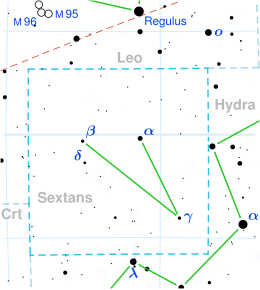| Observation data Epoch J2000.0 Equinox J2000.0 (ICRS) | |
|---|---|
| Constellation | Sextans |
| Right ascension | 09h 46m 23.61048s [1] |
| Declination | +01° 47′ 08.1160″ [1] |
| Apparent magnitude (V) | 5.64±0.01 [2] |
| Characteristics | |
| Spectral type | F0/2 IV [3] |
| U−B color index | +0.12 [4] |
| B−V color index | +0.34 [4] |
| Astrometry | |
| Radial velocity (Rv) | 7.8±0.3 [5] km/s |
| Proper motion (μ) | RA: −55.710 mas/yr [1] Dec.: −40.437 mas/yr [1] |
| Parallax (π) | 13.0508±0.0651 mas [1] |
| Distance | 250 ± 1 ly (76.6 ± 0.4 pc) |
| Absolute magnitude (MV) | +1.12 [6] |
| Details | |
| Mass | 2.01 [7] M☉ |
| Radius | 3.43±0.17 [8] R☉ |
| Luminosity | 26.29+0.34 −0.31 [1] L☉ |
| Surface gravity (log g) | 3.61±0.08 [9] cgs |
| Temperature | 6,919±111 [10] K |
| Metallicity [Fe/H] | +0.14 [11] dex |
| Rotation | 1.51 d [12] |
| Rotational velocity (v sin i) | 93.1±4.7 [12] km/s |
| Age | 1.06 [7] Gyr |
| Other designations | |
| 1 G. Sextantis [13] , AG+02°1299, BD+02°2246, FK5 2782, GC 13459, HD 84607, HIP 47960, HR 3879, SAO 117901, TIC 455274792 [14] | |
| Database references | |
| SIMBAD | data |
HD 84607 (HR 3879; 1 G. Sextantis) is a solitary star [15] located in the equatorial constellation Sextans. It is faintly visible to the naked eye as a yellowish-white hued point of light with an apparent magnitude of 5.64. [2] The object is located relatively close at a distance of 250 light-years based on Gaia DR3 parallax measurements, [1] but it is receding with a heliocentric radial velocity of 7.8 km/s . [5] At its current distance, HD 84607's brightness is diminished by an interstellar extinction of 0.18 magnitudes [16] and it has an absolute magnitude +1.12. [6]
HD 84607 has a stellar classification of F0/2 IV, [3] indicating that it is a slightly evolved star with the characteristics of a F0 and F2 subgiant. At the age of 1.06 billion years, [7] the star is ceasing hydrogen fusion at its core and is cooling and expanding onto the red giant branch. It has 2.01 times the mass of the Sun [7] and a slightly enlarged radius 3.43 times that of the Sun. [8] It radiates 26.29 times the luminosity of the Sun [1] from its photosphere at an effective temperature of 6,919 K . [10] HD 84607 is metal enriched with an iron abundance of [Fe/H] = +0.14 or 138% of the Sun's [11] and it spins fairly quickly with a projected rotational velocity of 93.1 km/s within 1.51 days. [12]
